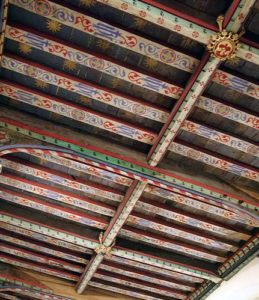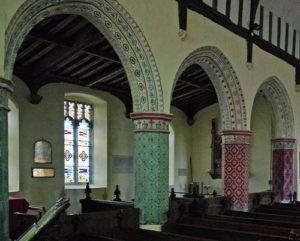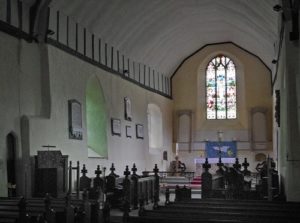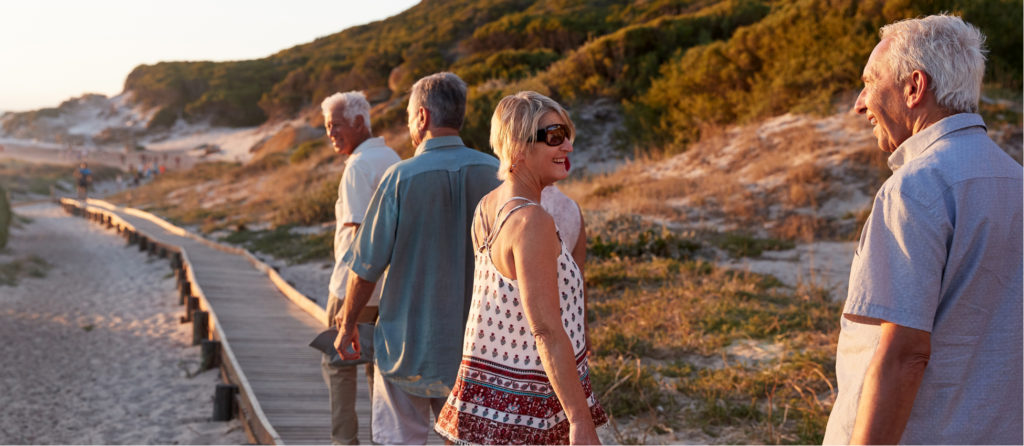We’ve often passed Theberton Church but this was the first time we’ve stopped to go inside, and what a find it is. Different to the majority of Suffolk churches, it has a round tower and is thatched. There are more surprises inside too.
The small Norman church was extended eastwards in the 13thC and an octagonal belfry added to the top of the tower. The south aisle with an integral porch date from the 15thC, as does the flushwork battlement round the top of the tower. The chancel was rebuilt during major restoration in the 19thC.
The flintwork of the original church is rough compared with the later 15thC work with its beautiful flushwork designs. There is no north aisle and the north wall is beginning to bow outwards and needing support from later big buttresses.
The priest’s door on the side of the south aisle is set in a stone frame with trefoils in the corners. Above is a carving of an unidentified man holding a shield.
It was late in the afternoon and the sun had disappeared behind the clouds making the church look and feel dark. It took a while for our eyes to adjust after stepping through the beautifully carved south door. Fortunately we managed to find a light switch to illuminate the most unexpected south aisle…..
It feels a large church as the nave and chancel are continuous. Octagonal pillars and pointed arches separate nave and south aisle. What is unusual is that these are painted in an attempt to show what a Pre-Reformation church might have looked like. It is certainly different, if a bit garish for modern tastes. The wood beam ceiling survives in the south aisle and again this is painted with IHS on the beams with blue and red scrolls and blue flowers in a red circle. At the ends of the beams are angels holding shields.
On the west wall is an is an ornate painted tomb of Sir Charles Doughty set under an ogee arch with angels on the top of the pinnacles. Along the bottom is a row of carved shields. Carved flowers, either roses or lilies support the pillars. It may not be to everyone’s taste but it is impressive. There are other memorials to Doughty’s on the walls.
The nave and chancel have a plaster ceiling covering the original wooden one and the bottom of the wood beams can still be seen. These still east on stone corbels with heads in the nave and angels in the chancel.
There is a consecration cross at the bottom of the tower. Set under the tower is a 15thC font, typical of so many we have seen in Suffolk. Round the stem are lions and woodwoses (wild men of the woods). Supporting the bowl are angel heads with carved flower heads. The panels of the bowl are carved with lions and angels holding shields with emblems of the Trinity, Passion, Cross and Blessed Sacrament.
The 15thC pulpit has nice tracery panels and now stands on a a modern base. Apparently this was moved three times during the 19thC restorations. When the vicar wanted it moved a fourth time the churchwarden suggested mounting it on wheels.
The pews in the nave are 19thC. Those in the chancel are older and have carved fronts with elaborate poppyheads.
Steps lead up to the altar under the 19thC stained glass window. There is a three seater sedilia on the south wall and a piscina. On the north wall is an aumbry (cupboard) still with its medieval door.
Before leaving the church check if the vestry door on the north wall is unlocked. If so, go into the vestry and turn round for a beautiful Norman doorway flanked by pillars with cushion capitals and two rows of zig zag carving on the arches.
And finally don’t miss the glass case on the wall of the porch with part of a German Zeppelin which was brought down nearby in 1917 with the death of 16 of its crew. They were buried in the churchyard before being removed to a military cemetery 60 years later. The rest of the crew were rounded up by the local policeman.
It had rained heavily while we were in the church. When we came out rain was pouring out of the pipes from the gargoyles.
This is a fascinating little church and completely unexpected. It’s ignored by many but is definitely worth stopping to visit.
The church is open everyday and there is plenity of parking in the Jubilee Hall behind the church.





